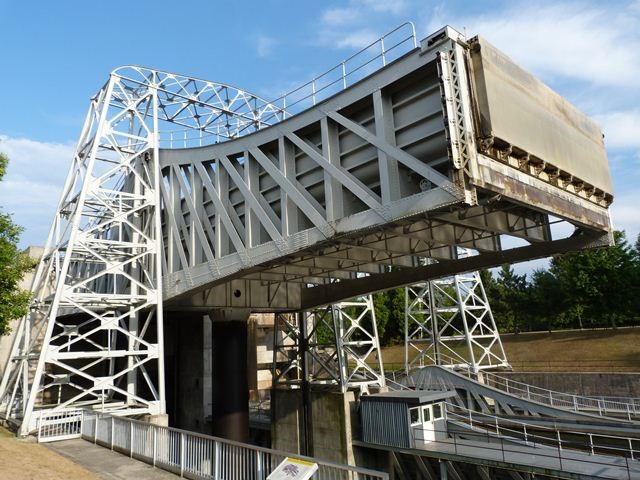Kirkfield Lift Lock Project Tests the Tenacity of IIA Inspectors
With more than a century in service (and counting), the Kirkfield Lift lock in Kawartha Lakes City, Ontario, has stood the test of time. Still, the years take a toll on even the most solidly built structure.

Non-destructive evaluations by qualified professionals play an important role in keeping this historic structure safe and sound.
Helping a Piece of History
A testament to human ingenuity, the Kirkfield Lift Lock is the world’s second highest hydraulic boat lift, with a lift of 15 meters (49 feet).
The Kirkfield Lift Lock is Lock 36 of 42 lockstations on the 386-kilometer Trent-Severn Waterway National Historic Site, which connects Lake Ontario and Georgian Bay. The expansive and historic lock system is operated and maintained by Parks Canada.
To ensure the structural integrity of the historic lift lock, Industrial Inspection & Analysis’ (IIA’s) Canadian Services team (previously known as Domson Engineering) was hired to provide inspection and testing of two press and rams (north and south), the hydraulic mechanisms that safely lift and lower boats between two different elevations of water.
Working as part of a large project team, IIA’s scope of work for the inspection included:
- Visual Inspection to assess the corrosion condition of the press and rams, and capture photographic and video records.
- Ultrasonic Thickness Testing of press and rams to measure thickness, and thus determine the extent of corrosion or damage
- Hammer Testing on bolts to determine if they were properly tightened or damaged.
- Eddy Current Testing to identify surface discontinuities and characterize the defects.
- Destructive Testing of a sample of flange material was performed by IIA’s Laboratory Services division.
On the Ropes
IIA’s inspections took place inside a 90-foot deep well in a roughly three-foot space between the well wall and the massive hydraulic cylinder inside. Due to extremely limited access, inspectors with Level 1 rope access certification from the Industrial Rope Access Trade Association (IRATA) were needed to complete this challenging inspection job.
Technicians who earn the Level 1 IRATA rope access certification are trained to lift and lower themselves on a set of ropes, as well as different techniques to maneuver around structures and obstacles. Because IRATA-certified inspectors have control of the ropes and the ability to maneuver themselves into position, they have a wider scope of movement than if someone else controls the ropes from above.
To complete the press and ram inspections, two IRATA-certified technicians made daily descents into the well over a two-week period. Slowly ascending, they performed visual inspections to check for corrosion and ultrasonic testing to measure the thickness of the steel housing.
Testing our Mettle
While rope access jobs are challenging under any circumstances, the Kirkfield Lift Lock project took discomfort to a new level.
In spite of sump pumps and heaters on the work site, the inspectors had to work in bone-chilling temperatures (around -10°C) under a continuous downpour of cold water from the Trent River, clad in head-to-toe rain gear and two pairs of gloves — all while suspended from ropes.
Biological hazards from decomposing fish and other marine life at the bottom of the well only complicated matters. If the inspectors’ ropes or feet disturbed the water, toxic hydrogen sulfide gas could release into the air. On several occasions, the inspectors’ gas meters alarmed, and they were forced to quickly climb 90 feet straight to the top and allow the well to ventilate before going back down.
At one point, the water level began to rise in the well after the massive, 200-pound pump became clogged. In a Herculean effort, one inspector wrapped the chain for the pump over his shoulder and was able to lift the pump out of the water enough to allow his fellow technician to clear the clog.
New Life for Historic Lift Lock
In addition to the environmental challenges faced by our inspectors, severe corrosion on the press and ram surfaces limited our testing capabilities. IIA adapted as needed to deliver the data needed by Parks Canada.
For example, in areas where severe corrosion limited our ability to perform ultrasonic thickness testing, IIA instead used a pit gauge to measure the section loss.
When UT testing or pit gauge measurements were not possible due to the presence of water and significant corrosion, the inspectors used chipping on the corroded surface and visual inspections.
By adapting to meet the challenges of the project, IIA was able to deliver critical data and mapping to show the location and severity of corrosion and other damage. IIA remains a trusted partner to Parks Canada today.
Thanks to IIA’s expertise, 25 years of experience, and the tenacity of our inspectors, Parks Canada can make informed decisions that will preserve this piece of Canadian history for decades to come.




